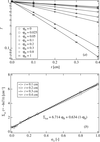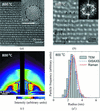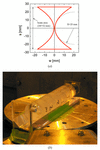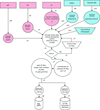issue contents
August 2009 issue

Cover illustration: Three-dimensional reconstructed crystal (purple), loop (yellow) and solvent (transparent pink) for a native DNA sample. Courtesy of Brockhauser, Di Michiel, McGeehan, McCarthy & Ravelli [J. Appl. Cryst. (2008), 41, 1057-1066].
research papers
The melt/air and melt/solid interface shapes of the miniature molten zone formed in a laser-heated pedestal growth system are studied numerically and with experimental verification.
Monoclinic crystals can be described in two settings: in the first setting the C2 rotation axis is parallel to the z axis and in the second setting it is parallel to the y axis. This article gives explicit transformations that need to be applied for texture analysis and for calculations of physical properties of materials with preferred orientation.
The performance of a spectrometer based on thin mosaic crystals was investigated for different spectroscopic methods using various X-ray sources. It was found that, even with low-power X-ray sources, advanced high-resolution X-ray spectroscopy can be performed.
A systematic procedure is developed to evaluate the frequency of twinning on pyramidal planes together with dislocation densities, active slip systems and crystallite size in hexagonal close packed metals. The procedure is incorporated into the eCMWP whole powder pattern evaluation method.
Open  access
access
 access
accessChanges in the structure of micelles of the surfactant polysorbate 80 (Tween 80) in 0–50% aqueous 1,4-dioxane solutions (pH 7.2, ionic strength 2.44 mM) were measured by small-angle X-ray scattering. The polysorbate 80 micelles changed from core–shell cylindrical micelles to core–shell discus micelles between concentrations of 20 and 30% 1,4-dioxane, and from core–shell discus micelles to core–shell elliptic discus micelles between concentrations of 40 and 50% 1,4-dioxane.
The uncertainty in measured diffraction intensity caused by particle statistics has been evaluated by a step-scan measurement about the rotation angle of a specimen-spinning attachment of a laboratory powder X-ray diffractometer. Crystallite sizes of quartz powder samples ranging from 3 to 22 µm have been successfully evaluated by further statistical analysis of the measured intensity data.
Open  access
access
 access
accessSystematic investigation of a large number of trial rigid-body refinements leads to an optimized multiple-zone protocol with a larger convergence radius.
NaOH attacks both the mineral and the organic components of human dentin, and it is believed to cause a change in crystal sizes and crystal disorder, mainly due to the collapse of the organic scaffold.
A novel method to evaluate the incoherent scattering intensity for hydrogen-containing materials is proposed. This method needs only the transmission and the sample thickness.
Structural and microstructural studies of eight human urinary calculi from eastern India using IR spectroscopy, X-ray diffraction, scanning electron microscopy and thermogravimetric differential scanning calorimetry have been carried out. Quantitative X-ray diffraction phase analysis using the Rietveld method indicated exclusively calcium oxalate monohydrate in three kidney stones, while the remaining five were mixtures of calcium oxalate monohydrate, calcium oxalate dehydrate and hydroxyapatite.
A technique for sample preparation prior to X-ray crystallographic analysis of protein crystals involving the use of acoustic radiation forces and a micro-machined fluidic device is introduced. Crystals can be positioned in a sequence along a channel and then individually removed with a loop, which is then mounted onto a goniometer.
Diffraction anomalous fine structure measurements of Fe/Fe oxide core–shell nanoparticles are reported. It is found that such measurements can provide useful structural information despite the high degree of disorder and the nanometre-size dimensions of the investigated system.
A novel simulation approach is presented for calculating small-angle scattering from photosynthetic membrane systems with complex geometries.
A method is developed for an exact calculation of the intensity of X-ray diffraction from nanocrystals containing plane defects using a Debye-function approach.
Theoretical and computer simulation approaches are developed for modelling the microbeam X-ray diffraction patterns from twisted lamellar ribbons. The angular broadening of diffraction peaks is accounted for by the varying crystal orientation caused by lamellar twisting. The proposed peak broadening analysis can be used, for example, in morphological studies of banded polymer spherulites.
This paper discusses the testing and simulation of aspherical neutron lenses as focusing elements for small-angle neutron scattering and their transparency with respect to thermal diffuse scattering.
Phase transformations in nanocrystalline Sm2Co17 alloy were investigated systematically by a series of annealing experiments.
The effect of particle size and heating rate on the transformation sequences of gibbsite to α-Al2O3 has been studied using coarse-grained C31 hydrate and fine-grained Hydral 710.
A statistically optimal method of combining Raman data with powder diffraction data is presented for use when analysing data derived from high-throughput experiments.
In this work, focusing doubly curved crystal X-ray optics were used in powder diffraction to produce an intense spot for use with small powder or polycrystalline samples.
short communications
The first use of the ARCS chopper spectrometer at the Spallation Neutron Source at Oak Ridge National Laboratory for powder-diffraction-based atomic pair distribution function analysis is reported. Its performance is benchmarked against the NPDF diffractometer at Los Alamos National Laboratory.
CIF applications
Open  access
access
 access
accessThe Crystallography Open Database (COD) is an ongoing initiative by crystallographers to gather all published inorganic, metal–organic and small organic molecule structures in one database, providing a straightforward search and retrieval interface. The COD adopts an open-access model for its >80 000 structure files.
computer programs
2DiffCalc is an easy to use pole figure calculation software connected to several neutron and synchrotron beam lines.
User-friendly software for the singular value decomposition of time-resolved crystallographic data has been developed. A graphical user interface guides the user through a quick and semi-automatic analysis of the data that ultimately leads to the atomic structures of reaction intermediates in conjunction with their kinetics.
MyCrystals is a simple user-friendly program developed to display and sort crystal images on the basis of the entered crystallization conditions.
laboratory notes
The effect of filtration on the number, size and quality of protein crystals is described.


 journal menu
journal menu













































